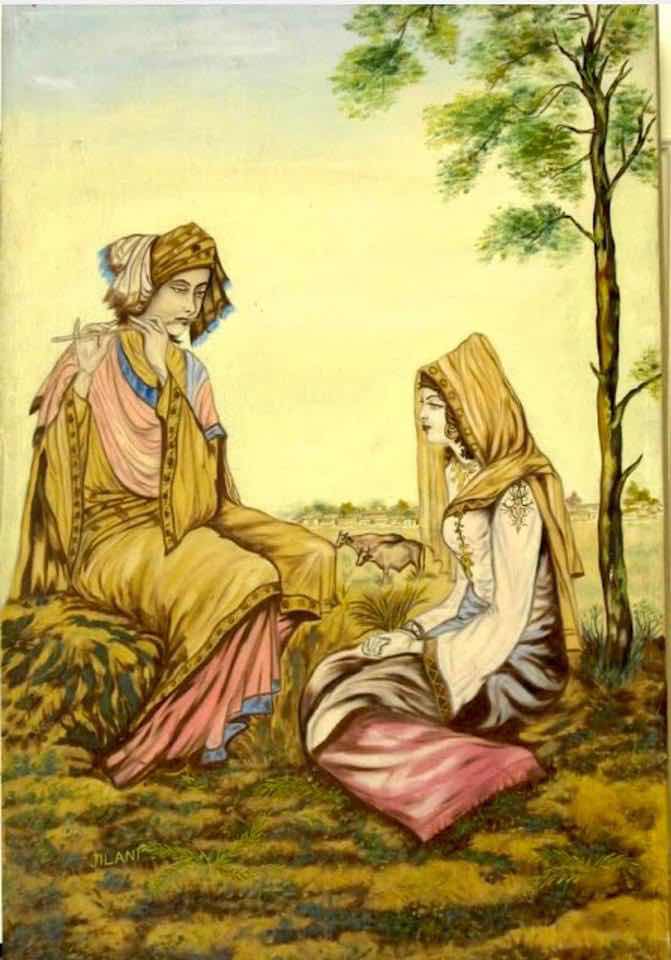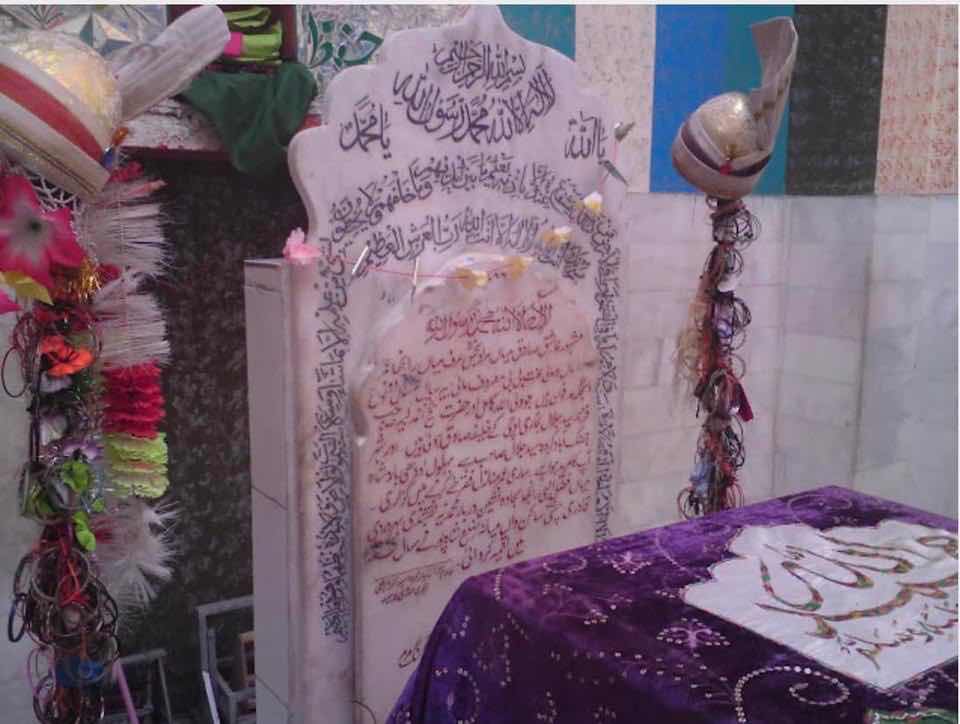The Kissa of Heer Ranjha …Original Story
We all are familiar with Waris Shah (Urdu: السيد وارث علي شاه النقوي الرضوي البهكري البدراني) , ਵਾਰਿਸ ਸ਼ਾਹ (Gurmukhi); 1722–1798) who was a Punjabi Sufi poet of Chishti order, renowned for his contribution to Punjabi literature by immortalizing the love story of Heer Ranjha. His poetic verse is a treasure-trove of Punjabi phrases, idioms and sayings. His minute and realistic depiction of the details of Punjabi life and political situation in the 18th century, remains unique and the entire poem is an album of colorful and enchanting pictures of life in the Punjab, deeply absorbing.
Waris Shah was deeply learned in Sufi and domestic cultural lore. His depiction of story of romantic love is a poetic expression of the mystical love of the human soul towards God – the quintessential subject in Sufism and a recurring theme in both Sufi and Sikh mysticism.
✨The Legend
Heer is an extremely beautiful woman, born into a wealthy family of the Sial clan in Jhang, West Punjab. Sials are Rajputs clan who inhabit Jhang region of West Punjab and founded the city of Sialkot. Ranjha (whose first name is Dheedo; Ranjha is the surname), was a Jatt of the Ranjha tribe. The Ranjha are found in Sargodha, Gujrat, Jhelum and Gujranwala districts of West Punjab.
Dheedo Ranjha was the youngest of four brothers and lives in the village of Takht Hazara by the river Chenab. Being the baby of the family, he led a life of ease, playing Wanjhli (flute). After being told off by his brothers, Ranjha leaves home and arrives in Jhang. Heer's father Chaudhary Chuchak offers Ranjha a job herding his cattle. Here he falls in love with Heer. She is also mesmerized by the way he plays his flute and falls in love with him. They meet each other secretly for many years until they are caught by Heer's uncle, Kaido, and her mother Malki. Heer is forced by her family and the local priest to marry another man named Saida Khera, a Jatt of Khaira clan.
Ranjha is heartbroken. He wanders the countryside alone, until eventually he meets Jogi (ascetic). Gorakhnath at Tilla Jogian (the 'Hill of Ascetics', located 50 miles north of the historic town of Bhera, Sargodha District, Punjab), Ranjha becomes a jogi himself, piercing his ears and renouncing the material world. Reciting the name of the Lord (Rabb) he wanders all over Punjab, eventually finding Rangpur, the village where Heer now lives as married woman.
Heer elopes with Ranjha with the help of Saida's sister Sehti who also elopes with her Balochi lover. The Khaira riders catch the eloping couple and beat Ranjha mercilessly. The couple are brought before Raja Adali of Qubala, demanding that Ranjha be put to death. Heer’s uncle Kaido also came to testify against Ranjha but Chaudhary Chuchak testifies in favour of the lovers. On the advise of elders, Raja Adali orders Saida to divorce Heer so she can marry Ranjha.
The two return to Heer's village, where Heer's parents agree to their marriage. However, on the wedding day, Kaido poisons her. Hearing this news, Ranjha rushes to aid Heer, but is too late, as she has already eaten the poison and has died. Brokenhearted once again, Ranjha eats the remaining poisoned Laddu (sweet) which Heer has eaten and dies by her side.
Heer and Ranjha are buried in Heer's hometown, Jhang. Love-smitten couples and others often pay visits to their mausoleum
Damodar Gulati ✍️
Damodar Gulati also known as Damodar Das Arora of Jhang was the greatest classical story teller of Punjab. He was the first to compose the legend of Heer Ranjha that captured the imagination of Punjabis. “Damodar is my name, Gulati is my caste. I came to the fiefdom of the Sial my heart using its discretion led me to spend my days there,” is what he says in the opening lines of his story.
Damodar is mentioned in the Adi Granth (compilation of sacred teachings of Guru Nanak). Bhai Guru Das (1551-1629), a celebrated Sikh religious writer, in one of his Vars (Epic) mentioned the names of some prominent early Sikh converts. One of them is Damodar the wise, resident of Sultanpur. The Sultanpur village is still there, on the road from Jhang to Shah Jewna where a number of Gulatis of Arora caste lived before the partition of India.
According to Prof Indu Banga of the Department of History, Panjab University, the earliest ‘kissa’ in Punjabi was that of Heer-Ranjha, written by Damodar Gulati in 1605 during Akbar’s reign. His work was rewritten by Ahmad Gujjar in the 1680s and then by Shahjahan Muqbil in the second quarter of the 18th century, she added. She said Waris Shah built upon Muqbil’s work and the status of a classic was accorded to his 1766 composition.
Luddan the sailor, feeling empathy for Ranjha who is tired and exhausted after his long travel, let him sleep on Heer’s couch on her river resort. Heer finding the privacy of her bed violated is furious. The beautiful and pampered daughter of a powerful clan chief, hurls a question at Ranjha: “What virtue do you possess that qualifies you to sleep in my bed?" Ranjha takes out a flute and plays it to mesmerize Heer.
Damodar composed the original Heer in 1605. Among the notable versions of the epic story were those of Ahmad Gujjar in the 1680s and then by Shahjahan Muqbil in the second quarter of the 18th century. Waris Shah built upon Muqbil’s work and the status of a classic was accorded to his 1766 composition.
Damodar is not just the foremost story teller of modern Punjab but also one of the most distinguished poets of the Punjabi language. Damodar is undoubtedly the first among the great story tellers of the Punjab, who with his holistic vision created characters that transcending the parochial came to embody the universal human predicament; individual versus repressive social structure. The unmistakable sign of his profound critical social consciousness is that he makes his protagonist, a woman, an eternal metaphor for defiance and resistance without which human love born of freedom would remain a hollow ideal.
The Kissa of Heer Ranjha …Original Story
We all are familiar with Waris Shah (Urdu: السيد وارث علي شاه النقوي الرضوي البهكري البدراني) , ਵਾਰਿਸ ਸ਼ਾਹ (Gurmukhi); 1722–1798) who was a Punjabi Sufi poet of Chishti order, renowned for his contribution to Punjabi literature by immortalizing the love story of Heer Ranjha. His poetic verse is a treasure-trove of Punjabi phrases, idioms and sayings. His minute and realistic depiction of the details of Punjabi life and political situation in the 18th century, remains unique and the entire poem is an album of colorful and enchanting pictures of life in the Punjab, deeply absorbing.
Waris Shah was deeply learned in Sufi and domestic cultural lore. His depiction of story of romantic love is a poetic expression of the mystical love of the human soul towards God – the quintessential subject in Sufism and a recurring theme in both Sufi and Sikh mysticism.

This particular painting depicts the moment when Heer first sets eyes on Ranjha, a young handsome trader from Central Asia, who has lost his way in the forest. Exhausted and hungry, he lay down to rest in what happened to be Heer's private 'takht' or 'nook'. Heer's companions are about to teach Ranjha a lesson for his trespass, when they are stopped by Heer, for whom it is 'love at first sight'. The dye is cast, as Heer gazes transfixed at the slumbering hero!
Painted by Ustad Allah Bux

Abdur Rehman Chugtai painting of Heer and Ranjha

Heer and Ranjha by Abdur Rahman Chugtai

Ranjha Jogi meete Heer by Sobha Singh

Samadh/Grave of Heer-Ranjha in Jhang,Pakistan
Courtesy: Gurinder Kaur
Notes, History and Musicology:
Heer Ranjha was written by many poets. Damodar Gulati, who also known as Damodar Das Arora, claims to be the eyewitness of this tale. His Qissa/story is deemed the oldest and the first Heer in Punjabi literature . He states in the poem that he is from Jhang—the home of Heer, one of the poem's two main characters. 16th century poet Shah Hussain also used story in his "Kafi" (poetry). Some historian said this story is came from Persia and other claimed word Heer was inspired by Greek goddess Hera. Some historians say that the story was the original work of Waris Shah, others say that Heer and Ranjha were real personalities who lived under the Lodi dynasty of the 15th and 16th century and that Waris Shah later utilized these personalities for his novel that he wrote in 1766. Waris Shah states that the story has a deeper meaning, referring to the unrelenting quest that man has towards God.
Bally Jagpal British musician has a song dedicated to their story. ‘RANJHA’ (sad love song).
The British musician Panjabi MC references the tale of Heer and Ranjha in his 2003 song Jogi. It has been sung by various Pakistani singers, including the classical/traditional artist Ghulam Ali.
The tale is mentioned in popular Bollywood songs such as "Ranjha" by Rupesh Kumar Ram from the movie Queen, "Ranjha Ranjha" by Rekha Bhardwaj and Javed Ali from the movie Raavanand "Dariya" from the movie Baar Baar Dekho.
The names of Heer and Ranjha have been referred in the song lyrics of "One Love: The Taj Anthem" by A.R. Rahman.
Alam Lohar is renowned for reciting Heer in various styles and one of the first international folk singers to bring this story in a song format.
The song Khaireyan De Naal from Shafqat Amanat Ali's debut solo album, Tabeer (2008), tells the tale of Heer Ranjha.
One of the songs of 2012 Hindi film Jab Tak Hai Jaan has been named "Heer".
Also, the 2018 Hindi film Race 3 has a song named "Heeriye" which refers to Heer and Ranjha.
In 2020, popular Indian YouTuber Bhuvan Bam wrote and sang "Heer Ranjha". The song depicts the brutal customs of society in the Indian subcontinent and has garnered more than 10 million views.
No comments:
Post a Comment